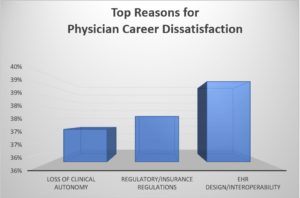The Physicians Foundation and Merritt Hawkins recently released their 2018 Survey of America’s Physicians. This year’s results are similar to what was found in the past few years’ surveys: More time is spent on paperwork, instances of burnout are high, and physicians are feeling pessimistic about the future of medicine.
The top 3 reasons that the 8,000+ surveyed physicians say are causing them to feel less love for their profession are EHRs, regulatory/insurance requirements and loss of clinical autonomy. Interestingly, it’s the EHRs and regulatory/insurance interference that physicians say are a big part of what’s keeping them from giving their patients the best care possible.
Opportunities to alleviate the burdens of practice management – including EHRs, regulatory compliance and payor negotiations – are becoming increasingly available. However, many dermatologists are cautiously weighing these options. Keeping their autonomy is of the utmost importance.
In the Exam Room
Working directly with patients is cited as the most favorable aspect of a career in medicine by a majority of physicians in the survey mentioned above. However, the exam room is getting crowded – insurers often have a say so in treatment plans and government regulations require physicians to spend more time inputting data than talking with patients.
Physicians don’t need to be micromanaged, they are the most qualified people to determine how patient care should be delivered. Clinical autonomy is at the core of QualDerm’s partnership model. Our physician partners are not tied to quotas and they are relied upon to help guide decisions at the practice, regional, and corporate levels. Our “True Partnership” model combines physicians’ expertise with business professionals’ expertise to help practices thrive while also ensuring the highest-quality care. As a testament to the benefits of this, QualDerm’s North Carolina and Ohio affiliated practices were both recently awarded the highest possible MIPS score of 100% for clinical performance. These results were possible thanks to high-caliber physicians working together with experienced IT professionals.
In the Future
Increased payor leverage, ever-changing government regulations, and industry consolidation are impacting dermatology. At the same time that physicians fear losing control in the exam room, they are also concerned that their individual voices are unheard on issues that can have long-term repercussions on their careers.
Already, dermatologists have been squeezed out of some payor networks and suffered rate cuts in others. Physicians who are part of a larger organization have an amplified voice and the back-office support to provide the quality metrics necessary to balance the scales during payor negotiations. In fact, QualDerm-affiliated practices have been able to negotiate reimbursement rate increases in North Carolina, Ohio, and Tennessee, with the largest payors in those markets.
However, some physicians are still leery of partnerships. They wonder how the partnership they enter into today might change in the future. Partnership agreements can be structured in a variety of ways. At QualDerm, we build in assurances that what our affiliated partners agree to today won’t fundamentally change in the future. To further ensure physicians maintain control over their careers, the QualDerm model is organized into state entities, with physician partners holding leadership positions within those entities. Decisions such as extending new affiliation offers or selling the entity cannot be made unless the state entity’s physician partners agree.
Learn more about how QualDerm’s True Partnership model preserves physician autonomy and gives physicians control over their careers.
Contact us to find out more about partnership opportunities or to discuss selling your practice.
